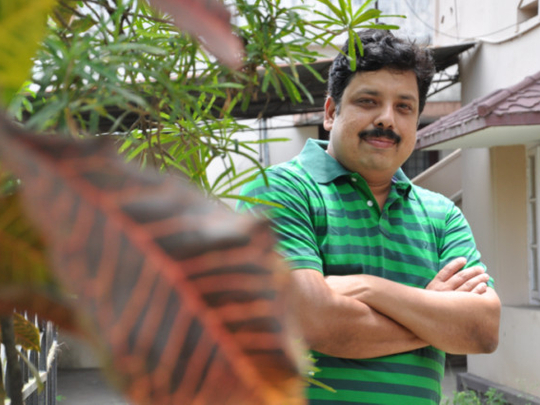
Delving into India’s mythological traditions seems to be flavour of the country’s writers in English of late. Several books in this genre have become bestsellers, the most famous being Amish’s Shiva Trilogy and Anand Neelakantan’s “Asura” and “Ajaya”.
Neelakantan’s first two books have been outstanding bestsellers. “Asura” has sold more than 2,00,000 copies in two years and “Ajaya” has sold more than 25,000 in four months.
Neelakantan, like Amish, had a flourishing corporate career when he took up his pen. “Being a Malayali, the urge to be with the underdog is more prominent in the DNA. This is something we share with the Bengalis,” he told Gulf News in an interview.
Born in a traditional Brahmin family in the southern Indian state of Kerala, Neelakantan’s surroundings provided him with the first introduction of the world of mythology. “My village has more than 100 temples. Growing up in such a place was indeed a blessing to me as far as an introduction to Indian Puranas are concerned. Even now, I need not rush to read any books for clearing even the obscure doubts on any of the Puranas or Shastras. I have to just phone any of my neighbours or relatives to get my doubts cleared,” Neelakantan says.
The Indian Oil officer-turned-writer says he was always fascinated about Ravana and Duryodhana, (the traditional villains of India’s two main epics, “Ramayana” and “Mahabharata”, respectively).
“The plain black-and-white portrayals of these anti-heroes on TV and in comic books have always looked ridiculous to me,” he says.
Neelakantan prefers to call himself a storyteller rather than a writer. “I am more interested in telling stories than the restrictive act of writing. Indians have some of the best and most varied story-telling techniques, from village dramas to puppet shows, classical arts, Hari Kathas, etc.
“Of course, films and television also are the modes of telling a story. Writing novels is just one among many story telling art. I wanted to tell a few stories in my own way. I do not have the means to say it in any other format than writing.”
Against popular belief, he believes there are no dark characters in Indian mythology. “We have no concept of absolute evil or absolute good. The demonising of Ravana or Duryodhana started in the later stages. There have been many stories or plays, such as ‘Oorubhanga’ by Bhasa, where such characters have been heroes. There is no concept of sin in our tradition and when sin there is no sin, there is no sinner or evil man. We are more comfortable with the concept of karma where each man eats the fruit of his own action.
“Our stories deal with the karma and their impact on men, women and gods. The grand lynching of Ravana during every Dussehera is a comparatively new tradition and is more confined to the northern parts of our country,” Neelakantan says.
Valmiki or Vyasa, he says, never call their anti-heroes evil. Rather, they just talk about the evil actions of their characters — and in that they do not spare their heroes either. “Over the years, this tradition got skewed and we have just become imitators of the western way of telling the stories where everything is black and white, and life is a perpetual struggle between the forces of dark and light. I am just trying to bring back the balance we Indians have lost somewhere.”
On the recent trend in modern Indian writing about retelling traditional Indian mythologies, Neelakantan says Indian English is a very new language. “In India, when a new language is being born, the first stories are about our mythology. We can see that “Ramayana” and “Mahabharata” were adapted in various Indian languages as poetry when they were evolving. Later, when our languages got into contact with literary art forms such as novels or short stories, the same thing happened.
“It happened in Bengali in the 19th century and in other languages a bit later. What we are seeing is the evolution of a new language, which is Indian English. There are many great authors such as Amitav Ghosh, Salman Rushdie, Arundhati Roy, etc, but they write for a western audience, if I dare to say so.
“My writing or Amish’s writing is aimed more at people who consider Indian English their language of thought. The subjects that we chose are in line with the classical trend of any Indian language that is in the evolution stage.”
Neelakantan has some strong views of Wendy Doniger’s works on Hinduism. “Doniger quotes the right scriptures and derives the wrong conclusions. Calling Gita a book of war is like saying the Old Testament is a book of a vengeful god or the ‘Das Capital’ a book of violence. It is an oversimplification of a civilisation and is more suitable to casual talk in a party than in a scholarly work.”
For Indians, he believes, Doniger’s work is as relevant as Katherine Mayo’s “Mother India”.
“The answer to her take on Hinduism is the same answer Mahatma Gandhi gave to Katherine Mayo’s ‘Mother India’. It is just a drain inspectors report on Hindu culture.”
Neelakantan is to tackle the same issue of the Gita in his second book on the Mahabharata, “Ajaya: The Rise of Kali”. “My take on Gita will be more like the open-ended questions of ‘Arjuna’ which [Nobel laureate Amartya] Sen explores, but I will be putting it as a part of my story. The conclusions that have to be drawn are left to the reader,” he says.
He does not fear any backlash like Doniger’s book faced due to his unconventional takes on mythological characters, seeped as they are in religious tradition. “For Wendy Doniger, there was no backlash. There were no one running around with a price on her head. It was the decision of the publisher who did not stand by the author. Wendy Doniger has the right to say what she wants and we have the right to disagree or agree.
“There are enough works critical about our scriptures, including books of Dr Ambedkar, Amartya Sen, etc for which no one had asked for a ban — and rightfully so. I have not faced anything other constructive criticism by my readers and the fact that ‘Asura’ has sold more than 200,000 copies in two years and ‘Ajaya’ has sold more than 25,000 in four months itself is a proof that people are willing to hear from the ‘other side’ with an open mind.
My novels are a part of a great tradition, which encourages the culture of Samvad or exchange of ideas rather than the confrontational approach of right and wrong.”
What next after the second book on the Mahabharata is out? A third anti-hero work is on the cards, Neelakantan reveals. “Most probably it will be Amatya, the story of Chanakya’s foe Rakshasa.”
For the uninitiated, Chanakya was the mentor and prime minister of Chandragupta Maurya, ancient India’s first major emperor. Rakshasa was a top civil servant in the Nanda dynasty, which Chandragupta ousted to begin his rule. Rakshasa made several attempts to assassinate Chandragupta and restore the old Nanda dynasty, but Chanakya’s guile finally succeeded in incorporating him into the Mauryan administration.
The term “Amatya” in Sanskrit refers to a civil servant/minister.
Or so the regular story goes. We will have to wait to see how the characters shape themselves under Neelakantan’s pen.








